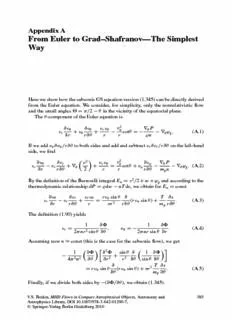Table Of ContentAppendixA
From Euler to Grad–Shafranov—The Simplest
Way
HereweshowhowthesubsonicGSequationversion(1.345)canbedirectlyderived
from the Euler equation. We consider, for simplicity, only the nonrelativistic flow
andthesmallanglesΘ=π/2−θ inthevicinityoftheequatorialplane.
Theθ-componentoftheEulerequationis
vr∂∂vrθ +vθr∂∂vθθ + vrrvθ − vrϕ2cotθ =−∇ θnP −∇θϕg. (A.1)
Ifweaddvϕ∂vϕ/r∂θ tobothsidesandaddandsubtractvr∂vr/r∂θ ontheleft-hand
side,wefind
(cid:6) (cid:7)
vr∂∂vrθ −vrr∂∂vθr +∇θ v22 + vrrvθ = vrϕ2cotθ +vϕr∂∂vθϕ − ∇mθPn −∇θϕg. (A.2)
p
BythedefinitionoftheBernoulliintegral E =v2/2+w+ϕ andaccordingtothe
n g
thermodynamicrelationshipdP = dw−nTds,weobtainfor E =const
n
vr∂∂vrθ −vrr∂∂vθr + vrrvθ = rvϕ(cid:19)si2nθ r∂∂θ(rvϕsinθ)+ mT r∂∂sθ. (A.3)
p
Thedefinition(1.90)yields
1 ∂Φ 1 ∂Φ
vr = 2πnr2sinθ ∂θ , vθ =−2πnrsinθ ∂r . (A.4)
Assumingnown ≈const(thisisthecaseforthesubsonicflow),weget
(cid:6) (cid:7)(cid:2) (cid:6) (cid:7)(cid:3)
1 ∂Φ ∂2Φ sinθ ∂ 1 ∂Φ
− +
4π2n2 ∂θ ∂r2 r2 ∂θ sinθ ∂θ
∂ T ∂s
=rvϕsinθ∂θ(rvϕsinθ)+(cid:19)2m ∂θ. (A.5)
p
Finally,ifwedividebothsidesby−(∂Φ/∂θ),weobtain(1.345).
V.S.Beskin,MHDFlowsinCompactAstrophysicalObjects,Astronomyand 385
AstrophysicsLibrary,DOI10.1007/978-3-642-01290-7,
(cid:2)C Springer-VerlagBerlinHeidelberg2010
386 A FromEulertoGrad–Shafranov—TheSimplestWay
Therefore,ifthefirsttermontheleft-handsideof(1.345)reallycorrespondsto
thecomponentvr∂vθ/∂r andthelasttermontheright-handside(cs =const)tothe
pressuregradient,theroleoftheterm∝ L ∂L /∂Φproveslesstrivial.Itcomprises
n n
both the effective potential gradient and, actually, the component vθ∂vθ/∂θ. The
formeristheleadingonenearthemarginallystableorbitr ≈3r ;thelatterbecomes
g
importantonlywhenapproachingthesonicsurface.
AppendixB
Nonrelativistic Force-Free Grad–Shafranov
Equation
Aswasnoted,thenonrelativisticversionoftheforce-freeequation(2.101)reduces
tozeroofAmpere’sforce[∇ ×B]×B,whichimpliesthatthecontributionofthe
electricfieldisnottakenintoaccount.Thus,theGSequationhastheform
2 ∂Ψ 16π2 dI
−∇2Ψ+ − I =0. (B.1)
(cid:19) ∂(cid:19) c2 dΨ
Aswesee,themaindifferencefromtherelativisticversionisthatthereisnointegral
ofmotionΩ inEq.(B.1).Hence,
F
(cid:129) thenonrelativisticGSequationversionhasnocriticalsurface;
(cid:129) accordingtothegeneralformulab=2+i −s(cid:16),foranumberofboundarycon-
ditionswehaveb=3,i.e.,theproblemrequiresthreeboundaryconditions.
ThenonrelativisticGSequationcanbesubstantiallysimplifiedifweconsidera
one-dimensionalcylindricalconfiguration;thecurrent I(Ψ)isthelinearfunctionof
themagneticfluxΨ.Itisconvenienttowritethisrelationas
c
I(Ψ)= Ψ, (B.2)
4π(cid:19)
0
where(cid:19) istheconstantoflengthdimension.Inthiscase,Eq.(B.1)becomeslinear:
0
d2Ψ 1 dΨ
− +Ψ=0. (B.3)
dx2 x dx
r r r
Herex =(cid:19)/(cid:19) .ThesolutiontoEq.(B.3)istheknownfields
r 0
B = B J (x ), (B.4)
z 0 0 r
Bϕ = B0J1(xr), (B.5)
387
388 B NonrelativisticForce-FreeGrad–ShafranovEquation
where J (x ) and J (x ) are the Bessel functions. As we see, in a stable cylindri-
0 r 1 r
cal discharge at some distance from the axis, the longitudinal magnetic field must
changeitsdirection,whichisobservedexperimentally(see,e.g.,Kadomtsev,1988).
AppendixC
Part-Time Job Pulsars
Recently,Krameretal.(2006)havereportedonthethoroughstudyofradiopulsar
B1931+24. The difference between this pulsar and ordinary radio pulsars is that
theformerhas5–10dactivephases.Therefore,theradioemissionisswitchedoffin
lessthan10sandisactuallyundetectableforthenext25–35d.Itisveryimportant
thattheneutronstarspin-downisdifferentintheonandoffstates:
Ω˙ =1.02×10−141/s2, (C.1)
on
Ω˙ =0.68×10−141/s2. (C.2)
off
Hence
Ω˙
on =1.5. (C.3)
Ω˙
off
Later,thesameratiowasdetectedforPSR J1832+0031(t ∼300d,t ∼700d).
on off
This discovery offers a unique opportunity to observe both energy-loss mecha-
nismsforthesameradiopulsar(BeskinandNokhrina,2007;GurevichandIstomin,
2007).Besides,wecanclarifythepulsarbrakingmechanism.Thus,itislogicalto
supposethatintheonstatetheenergyreleaseisduetothecurrentlossesonlyand
intheoffstatetothemagnetodipoleradiation(inthiscase,itisnottheplasma-filled
magnetosphere).Using(2.5)and(2.178),wefind
Ω˙ 3f2
on = ∗ cot2χ, (C.4)
Ω˙ 2
off
whichyieldsthereasonablevalueoftheinclinationangleχ ≈60◦.
Ontheotherhand,ifwetakerelation(2.260)fortheon-stateenergylosses(Spitkovsky,
2006)
1 B2Ω4R6
W = 0 (1+sin2χ), (C.5)
tot 4 c3
389
390 C Part-TimeJobPulsars
weget
Ω˙ 3 (1+sin2χ)
on = . (C.6)
Ω˙ 2 sin2χ
off
Itisobviousthatthisratiocannotbeequalto1.5foranyinclinationangle.
Comparingthetheorywiththeobservationsofradiopulsar B1931+24,wecan
makethefollowingconclusions(GurevichandIstomin,2007):
1. It is for the first time that in the PSR B1931+24 off state the spin-down of
themagnetizedneutronstarrotationduetothemagnetodipoleradiationenergy
losseswasobserved.
2. Therearereallycurrentlosseswhicharefullydifferentfromthevacuumones.
3. As the switching time between the on and off states is very short, the plasma
sourceistobelocatedintheopenpartofthemagnetosphere.
AppendixD
Special Functions
D.1 LegendrePolynomials
The Legendre polynomials of the first and second kind P (x) and Q (x) are the
m m
solutionstotheequation
(cid:2) (cid:3)
d d
(1−x2) f(x)=qf(x). (D.1)
dx dx
Theyhavetheeigenfunctions
P (x) = 1, (D.2)
0
P (x) = x, (D.3)
1
3x2−1
P (x) = , (D.4)
2
2
5x3−3x
P (x) = , (D.5)
3
2
...
and
(cid:6) (cid:7)
1 1+x
Q (x) = ln , (D.6)
0 2 1−x
(cid:6) (cid:7)
x 1+x
Q (x) = −1+ ln , (D.7)
1 2 1−x
(cid:6) (cid:7)
3x 3x2−1 1+x
Q (x) = − + ln , (D.8)
2 2 4 1−x
(cid:6) (cid:7)
2 5x2 5x3−3x 1+x
Q (x) = − + ln , (D.9)
3 3 2 4 1−x
...
andtheeigenvalues
391
392 D SpecialFunctions
q =−m(m+1). (D.10)
m
ThegeneralexpressionforP (x)is
m
1 dm
P (x)= (x2−1). (D.11)
m 2mm!dxm
Since the Legendre polynomials are a complete orthogonal system in the interval
−1< x <1,anyfunction f(x)canbegivenas
(cid:20)∞
f(x)= (f) P (x), (D.12)
m m
m=0
where
(cid:17)
2m+1 1
(f) = P (x)f(x)dx. (D.13)
m m
2 −1
D.2 BesselFunctions
TheBesselfunctionsofthefirstkind J (x)arethesolutionstotheequation
m
d2f(x) df(x)
x2 +x +(x2−m2)f(x)=0, (D.14)
dx2 dx
havingnosingularityatx =0:
(cid:14)x(cid:15)m(cid:20)∞ 1 (cid:6)−x2(cid:7)k
J (x)= . (D.15)
m 2 k!Γ(m+k+1) 4
k=0
Inparticular,
x2 x4 x6
J (0)=1− + − +··· , (D.16)
0
4 64 2304
x x3 x5 x7
J (x)= − + − +··· , (D.17)
1
2 16 384 18432
asx →0,and
(cid:31)
(cid:14) (cid:15)
π mπ π
J (x) = cos x − − , (D.18)
m
2x 2 4
asx →∞.
TheMacdonald(modifiedBessel)functions K (x)arethesolutionstoequation
m
D.3 HypergeometricFunction 393
d2f(x) df(x)
x2 +x −(x2+m2)f(x)=0. (D.19)
dx2 dx
Theyhaveasingularityatx =0,butvanishatinfinity.Inparticular,
K (x)=−lnx +ln2−γ, (D.20)
0
1
K (x)= , (D.21)
1
x
asx →0,and
(cid:31)
π
K (x) = e−x, (D.22)
m
2x
asx →∞.Hereγ ≈0.577istheEulerconstant.
D.3 HypergeometricFunction
Thehypergeometricfunction F(a,b,c,x)isthesolutionstotheequation
d2f(x) df(x)
x(1−x) +[c−(a+b+1)x] −abf(x)=0, (D.23)
dx2 dx
havingnosingularityatx =0:
ab x a(a+1)b(b+1) x2
F(a,b,c,x) =1+ +
c 1! c(c+1) 2!
a(a+1)(a+2)b(b+1)(b+2) x3
+ +··· . (D.24)
c(c+1)(c+2) 3!
Thus, if a or b is an integer less than or equal to zero, the function F(a,b,c,x)
reducestoapolynomial.
Description:ApJ 332,. 646–658 (1988) 3, 8, 14. Abramowicz, M.A., Kato, S.: Constraints ApJ 246, 314–320 (1981) 360 ApJ 204, 889–896 (1976) 1, 236, 286 .. Frankl', F. I.: On the problems of Chaplygin for mixed sub- and supersonic flows.

